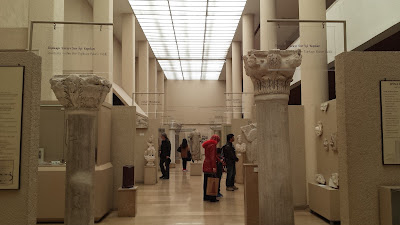
There are many districts to explore in Istanbul. As for me, I just decided to stick to Sultanahmet because I am just here for two days anyway and I want everything to be chill. You know you want to take things slow when you opt to split two destinations facing each other into two different sightseeing days. And so day two was reserved for the Blue Mosque as well as Topkapi Palace. But the museum and palace of Topkapi were closed because it was a holiday, which made me settle for the Archaeology Museum.
And some serious nerdgasm occurred in that museum. So I’ve been having this weird fascination with dead languages recently, right? And I have made a ten-year plan for me to study ancient languages starting with Latin and followed by Ancient Greek. These two classical languages will take six years altogether, after which I plan to take advantage of free German university education and do a bachelor’s degree in Assyriology and Egyptology, where Middle Egyptian and Akkadian will be tackled.

What does this have to do with the Archaeology Museum? Well, aside from rocks and preserved artifacts relevant to the arts, languages also play a big part in the history of early human civilizations. One area of that museum was reserved especially for that. When we talk about Mesopotamia, Akkadian and Sumerian come into play while hieroglyphs are obviously the trademark for ancient Egypt. It was the first time for me to see a good collection of tablets with 4,000-year-old cuneiform inscriptions on them. Wow.



If you are not familiar with cuneiform, this form of writing uses arrows and lines, and somehow seems to be the basis for the Wingdings font on Microsoft Word. Well, not really. Wingdings would look more like hieroglyphs, actually. But whatever. I usually hate museum tours but this one made me want to go back to school so bad. I guess this is what you need when you begin to lose motivation in pursuing a field related to ancient history. Okay, too much geeky verbal diarrhea has been unleashed here. Let’s move on.

For those not interested in dead languages, you can always attempt to appreciate ancient art. Some ancient civilizations were big on mosaics, although the splash of color is kind of limited given their preference for large rocks and boring whitish marble. In any case, most of them considered size to be an indication of grandeur, so there are many giant structures in that museum which can be good backdrops for an ancient-themed selfie. That particular wing is rather small, though, and perhaps an hour will do.

Go farther back and you will see a small building with glistening blue tiles. You’ve guessed it right, that’s the tiled museum dedicated to tiles and ceramics, of which I’m not a fan. That simply meant that I checked it out for five minutes, realized that it wasn’t my cup of tea, took a goodbye selfie, and went ahead to explore other options. There are sculptures at the garden straight from the Byzantine period so you might also want to check that out.

If not, then go to the last unexplored area, which is the bigger museum dedicated to the history of Istanbul and its neighboring cultures. There you will see a lot of art pieces that defined the history of the region which includes modern day Greece and even Rome to some extent. The first hall is littered with busts and bigger than life sculptures of celebrated personalities back in the day. Each region had its own defining characteristic in terms of artistic style but I think special knowledge of art history is needed for that.

There are three more floors upstairs and it gets darker and cooler as you ascend to a higher floor. The topmost floor is reserved for neighboring Cyprus and Syria. What I saw there were mostly pottery, human skeletons, and a sarcophagus or two. That hall is rather dark and the panels are predominantly black, which gives off an eerie kind of vibe, like some ancient curse will come alive and follow you home. You know that kind of sinister shit you see in movies?

The hall dedicated to the history of Istanbul is on the second floor, if I’m not mistaken. This is probably the section I enjoyed the most simply because of Istanbul’s colorful history. Once known as Byzantium, this city once rivaled Rome in terms of significance and even outlasted it as the Roman Republic met its demise. Captured by the Ottomans, what was once Christian suddenly became Muslim, and the resulting marriage of cultures has left behind an artistic legacy that’s simply hard to ignore.

I really appreciate the history lesson, although I must admit that too much art bores me to some extent. If anything, this trip sort of strengthened my motivation to pursue ancient languages. I saw some Ancient Greek in that museum and it made me look forward to finishing Latin and adding another dead language to my list. A return visit is definitely due in the future. As I said, this visit just came five years too early. But hey, it reinvigorated my interest in the field just when I thought that it was already withering away.

The day ended at the Blue Mosque, too early in fact because it was just 4 PM when I called it quits. The Sultan Ahmed Mosque is spectacular even with the sun against it. In this manner, the Hagia Sophia seems to be hogging the spotlight, literally, because it’s facing the sun. But the mosque on the other side of the park is not to be outdone, what with the plethora of tourists and locals alike crowding it. There is always a unique photo waiting to be taken.

Going inside is tricky because you have to follow the prayer schedule. If you didn’t know, well, this mosque is fully operational, which means people actually come here to pray. The entrance for visitors is separate from that of praying Muslims. You can’t wear anything sleeveless nor shorts that will expose your knees. You need not worry if you do, though, because the mosque’s administration provides shawls and cloth to cover you for free. Footwear should be removed and placed in a plastic bag provided at the entrance.

You should definitely go inside if you have a thing for intricately designed ceilings. While I think that the Hagia Sophia reigns supreme when it comes to mind-blowing ceiling design, the Blue Mosque comes in close second thanks to the hypnotic patterns etched on its domes. Other than this, however, there is nothing more to see, unless you are Muslim and going there to pray. There is a separate area for tourists inside, by the way. The middle part is reserved for those who are praying.

And this is where my tour of Istanbul ended. There are more places to see such as the Galata area which I think includes Taksim, the Prince’s Islands accessible by ferry, the Bosphorus via a river cruise, the Sea of Marmara, as well as the Asian side. If you really want to enjoy Istanbul, perhaps a week would be fine to maximize your tour. And that’s just the former capital. Turkey is huge. There’s still Cappadocia, Pamukkale, Ephesus, Ankara. The list just goes on and on. Happy sightseeing! I’ll be back, Byzantium.
[ISTANBUL] Archaeological Nerdgasm, Domes, and Minarets






_poster.jpg)



0 creature(s) gave a damn:
Post a Comment